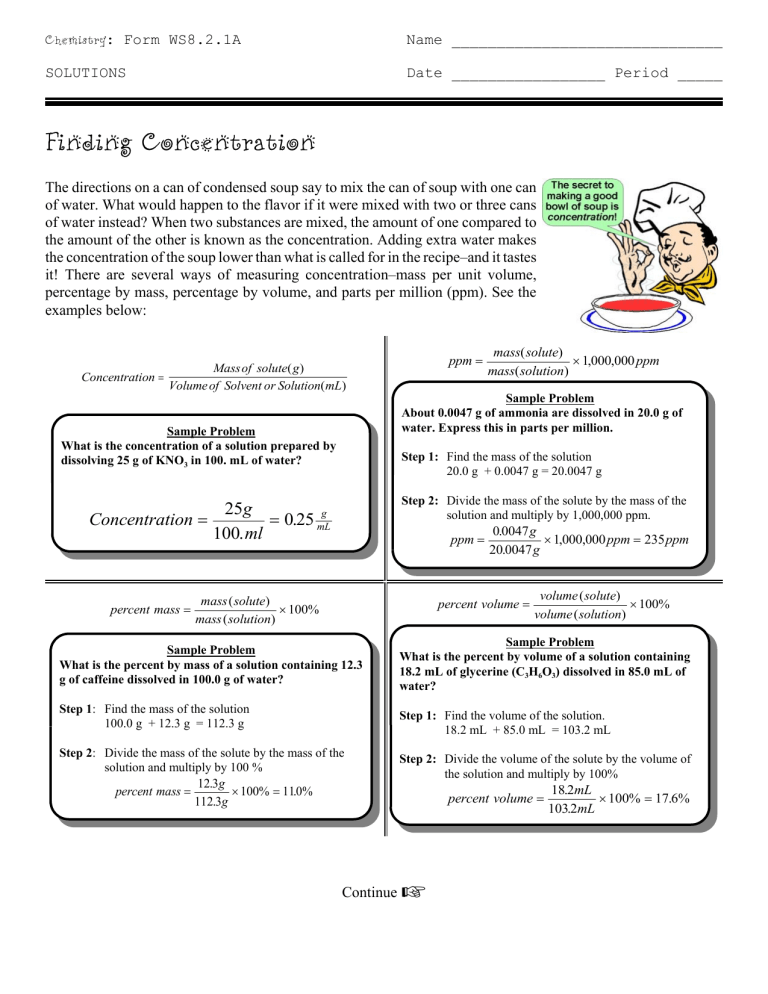
Chemistry: Form WS8.2.1A Name ______________________________ SOLUTIONS Date _________________ Period _____ Finding Concentration The directions on a can of condensed soup say to mix the can of soup with one can of water. What would happen to the flavor if it were mixed with two or three cans of water instead? When two substances are mixed, the amount of one compared to the amount of the other is known as the concentration. Adding extra water makes the concentration of the soup lower than what is called for in the recipe–and it tastes it! There are several ways of measuring concentration–mass per unit volume, percentage by mass, percentage by volume, and parts per million (ppm). See the examples below: Mass of solute( g ) Concentration = Volume of Solvent or Solution(mL) Sample Problem What is the concentration of a solution prepared by dissolving 25 g of KNO3 in 100. mL of water? mass( solute) × 1,000,000 ppm mass( solution) Sample Problem About 0.0047 g of ammonia are dissolved in 20.0 g of water. Express this in parts per million. Step 1: Find the mass of the solution 20.0 g + 0.0047 g = 20.0047 g Step 2: Divide the mass of the solute by the mass of the solution and multiply by 1,000,000 ppm. 25g g Concentration = = 0.25 mL 100. ml percent mass = ppm = ppm = mass ( solute) × 100% mass ( solution) 0.0047 g × 1,000,000 ppm = 235 ppm 20.0047 g percent volume = Sample Problem What is the percent by mass of a solution containing 12.3 g of caffeine dissolved in 100.0 g of water? Step 1: Find the mass of the solution 100.0 g + 12.3 g = 112.3 g volume ( solute) × 100% volume ( solution) Sample Problem What is the percent by volume of a solution containing 18.2 mL of glycerine (C3H6O3) dissolved in 85.0 mL of water? Step 1: Find the volume of the solution. 18.2 mL + 85.0 mL = 103.2 mL Step 2: Divide the mass of the solute by the mass of the solution and multiply by 100 % 12.3g percent mass = × 100% = 110% . 112.3g Continue Step 2: Divide the volume of the solute by the volume of the solution and multiply by 100% percent volume = L 18.2mL × 100% = 17.6% 103.2mL Finding Concentration Chemistry: Form WS8.2.1A SOLUTIONS Page 2 Answer the questions below based on the sample problems. 1. What is the concentration of 45 mL of a solution containing 9.0 g of KClO3? 6. If 19 mL of alcohol are dissolved in 31 mL of water, what is the percentage by volume of alcohol? 2. A solution is prepared by mixing 20.0 g of NaNO3 with 100. mL of water. What is the percentage mass of the solution? (Assume density of water is 1 g/mL) 7. If 0.002 g of PbCl2 are dissolved in 2.0 L of water, how many parts per million are dissolved? (Assume density of water is 1 g/mL) 3. A 250. mL sample of air at STP contains approximately 52.5 mL of O2(g). What is the percentage of oxygen in air? 8. If 15 g of KNO3 are dissolved in 235 g of water, what is the percentage of solute by mass? 4. A polar solvent is prepared by mixing 27.5 mL of propanone with 222.5 mL of water. What is the percentage by volume of propanone in the mixture? 9. What is the percentage by mass of a solution prepared with 34 g of KI and 126 g of water? 5. How many parts per million of sulfur dioxide are there in a solution containing 0.065 g of sulfur dioxide in 5,000 mL of water? (Assume density of water is 1 g/mL) 10. What is the concentration of a solution made with 0.056 g of CO2(g) and 200 mL of water? © Evan P. Silberstein, 2003


